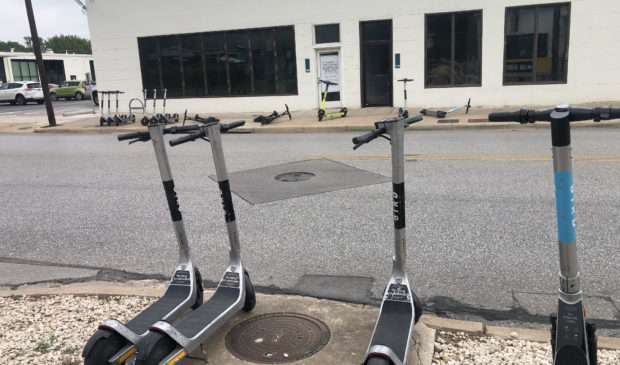New scooter rules are in effect now
Tuesday, April 2, 2024 by
Elizabeth Pagano As of this month, new regulations dictate how scooters operate in Austin.
“I think it might be one of the biggest complaints we get in the office,” said Council Member Zo Qadri, who represents downtown. “For me, it’s not as much about the visual clutter. It’s about accessibility and safety.”
Richard Mendoza, director of Transportation and Public Works, explained to Council’s Mobility Committee that he had been working on the new rules in cooperation with Bird and Lime in a process that was launched last fall. They were put into effect April 1.
“I am not anti-scooter,” Mendoza said. “And I understand that, in terms of providing a service, especially with regards to last-mile connectivity, this recent asset and service has filled a very valuable space for our community. However, with anything new, there’s a period of adjustment and there’s an experience of, perhaps, unintended challenges that we’ve been encountering.”
Specifically, Mendoza said challenges centered on safety and the proliferation and clustering of scooters, which has been damaging to the environment, ADA compliance and access to storefronts, as well as general aesthetics.
“Some of these devices found their way into some of our waterways, which presented significant environmental concerns,” he said.
To address these concerns, the city has now:
- Reduced the number of licensed vendors from three to two
- Reduced the number of individual scooters from more than 14,000 to 8,700, with a proposed further reduction to 6,700, with more scooters allowed during special events like South by Southwest
- Reduced maximum scooters allowed downtown from 4,500 to 2,250
- Discontinued the use of dockless e-bikes (seated scooters will still be permitted)
- Reduced the maximum speed from 15 miles per hour to 10 mph overnight (from 10 p.m. to 5 a.m.) in the main entertainment districts of the urban core in an effort to reduce serious head injuries
- Started the creation of designated device staging areas.
Mendoza said that different cities had taken different approaches to the issue with everything from total moratoriums on scooters to the construction of infrastructure to control the environment that scooters operate within. He said that Austin sought to have a dialogue with the micromobility companies as partners to figure out how to address the challenges. When asked why he worked only with vendors, instead of the usual stakeholder process, he said that he saw a need to move faster than typical to address safety issues.
Removing scooters entirely from Congress Avenue was “still in conversation,” Mendoza said as part of a larger conversation about reenvisioning the street as the Main Street of Texas.
Establishing and delineating staging areas will begin this month and continue through the summer.
The Austin Monitor’s work is made possible by donations from the community. Though our reporting covers donors from time to time, we are careful to keep business and editorial efforts separate while maintaining transparency. A complete list of donors is available here, and our code of ethics is explained here.
You're a community leader
And we’re honored you look to us for serious, in-depth news. You know a strong community needs local and dedicated watchdog reporting. We’re here for you and that won’t change. Now will you take the powerful next step and support our nonprofit news organization?










